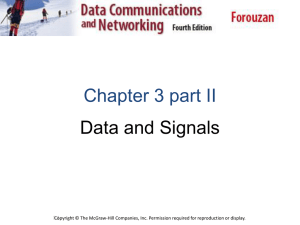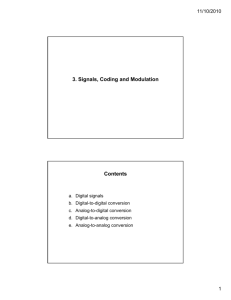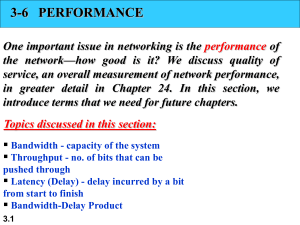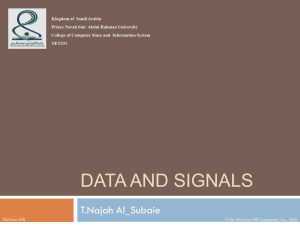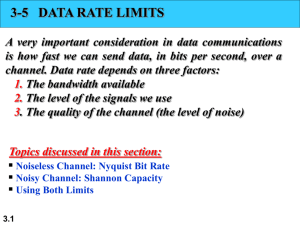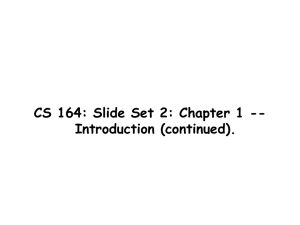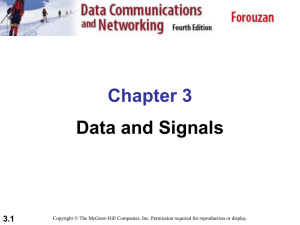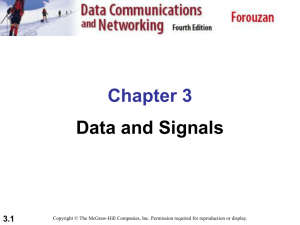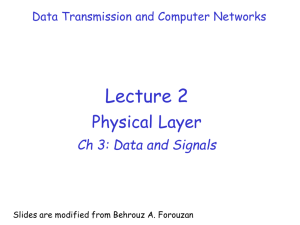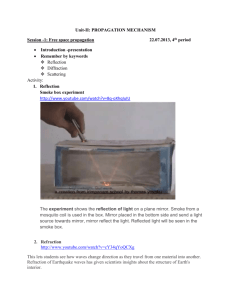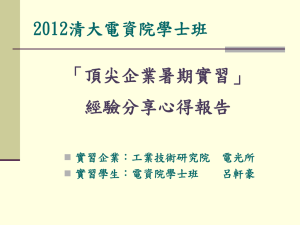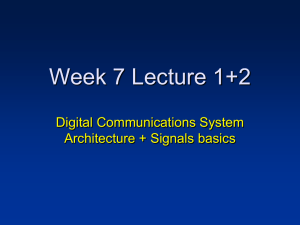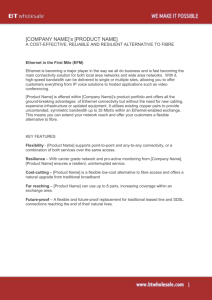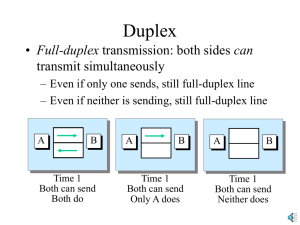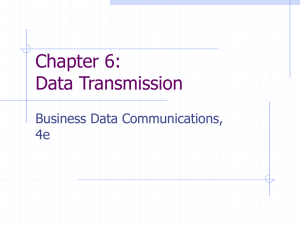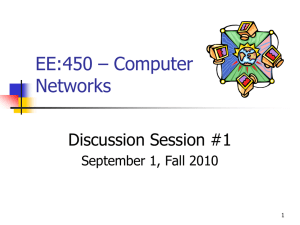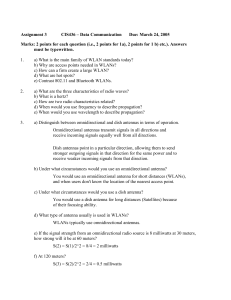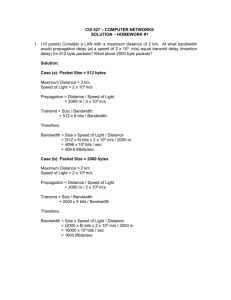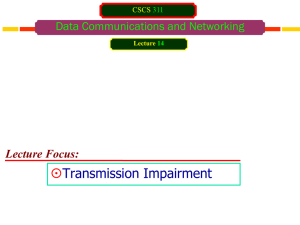Theoretical Basis of Data Communication
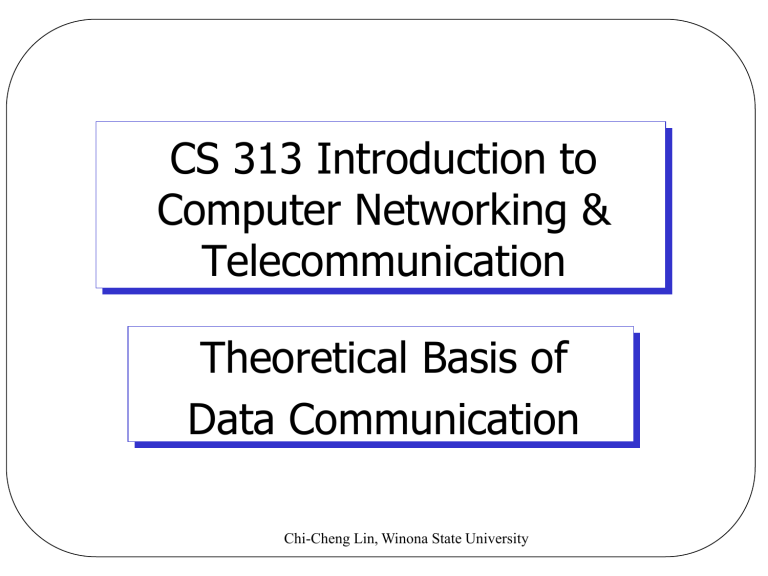
CS 313 Introduction to
Computer Networking &
Telecommunication
Theoretical Basis of
Data Communication
Chi-Cheng Lin, Winona State University
Topics
Data Communication Performance
Measurements
Analog/Digital Signals
Time and Frequency Domains
Bandwidth and Channel Capacity
2
Data Communication Performance
Measurements
Throughput
How fast data can pass through an entity
Number of bits passing through an a second imaginary wall in
Bit time
Duration of a bit (time for a bit ejected into network)
1 / throughput
Propagation time (propagation delay)
Time required for one bit to travel from one point to another
Propagation speed depends on medium and signal frequency
3
Message Transmission Delay
Total transmission delay
= (size_of_message / throughput) + propagation_time
Sender 01101… Time
Receiver t
0 first bit sent t
1 last bit sent propagation_time t
01101…
2 first bit arrived t
3 last bit arrived
4
Message Transmission Delay - Example
What is the transmission delay of a 2 KB message transmitted over a 2 km cable that has a throughput
40 Mbps and a propagation delay of 8 µs/km?
Answer:
Total transmission delay
= (size_of_message / throughput) + propagation_time
= (2048 x 8 bits / 40x10 6 bits/sec) + 8 µs/km x 2 km
= 409.6 x 10 -6 sec + 16 µs
= 425.6 µs
What is the bit time?
5
Signals
Information must be transformed into electromagnetic signals to be transmitted
Signal forms
Analog or digital
6
Analog/Digital Signals
Analog signal
Continuous waveform
Can have a infinite number of values in a range
Digital signal
Discrete
Can have only a limited number of values
E.g., 0 and 1, i.e., two levels, for binary signal
7
Time Vs. Frequency Domain
A signal can be represented in either the time domain.
domain or the frequency
8
Period (Time) and Frequency
Unit
Seconds (s)
Equivalent
1 s
Unit
Hertz (Hz)
Milliseconds (ms) 10 –3 s Kilohertz (KHz)
Microseconds (ms) 10 –6 s Megahertz (MHz)
Nanoseconds (ns)
Picoseconds (ps)
10
10
–9
–12 s s
Gigahertz (GHz)
Terahertz (THz)
Equivalent
1 Hz
10 3 Hz
10 6 Hz
10 9 Hz
10 12 Hz
9
Composite Signals
A composite signal can be decomposed into component sine waves harmonics
The decomposition is performed by
Fourier Analysis
DC component is the one with frequency 0.
10
Frequency Spectrum and Bandwidth
Frequency spectrum
Collection of all component frequencies it contains
Bandwidth
Width of frequency spectrum
11
Digital Signal - Decomposition
A digital signal can be decomposed into an infinite number of simple sine waves
(harmonics)
A digital signal is a composite signal with an infinite bandwidth.
More harmonics components
= better approximation
Animation
Significant spectrum
Components required to reconstruct the digital signal
12
Bandwidth-Limited Signals
(a) A binary signal and its root-meansquare Fourier amplitudes.
13
Bandwidth-Limited Signals (2)
(b) – (e) Successive approximations to the original signal.
14
Channel Capacity
Channel capacity
Maximum bit rate a transmission medium can transfer
Nyquist theorem for noiseless channels
C = 2 H where log
2
V
C : channel capacity (bit per second)
H : bandwidth (Hz)
V : signal levels (2 for binary)
C is proportional to H
bandwidth puts a limit on channel capacity
15
Channel Capacity
Shannon Capacity for noisy channels
C = H where log
2
(1 + S/N )
C : (noisy) channel capacity (bps)
H : bandwidth (Hz)
S/N : signal-to-noise ratio dB = 10 log
10
S/N
In practice, we have to apply both for determining the channel capacity.
16
Examples
Noiseless channel.
Consider a noiseless channel with a bandwidth of 3000 Hz transmitting a signal with two signal levels. What is the maximum bit rate of this channel?
Noiseless channel.
Consider the same noiseless channel, transmitting a signal with four signal levels (for each level, we send two bits). What is the maximum bit rate of this channel?
Extremely noisy channel.
Consider an extremely noisy channel in which the value of the signal-to-noise ratio is almost zero. In other words, the noise is so strong that the signal is faint. What is the channel capacity of this channel?
17
Examples
Theoretical highest bit rate of a regular telephone line.
A telephone line normally has a bandwidth of 3000 Hz (300 Hz to 3300 Hz). The signal-to-noise ratio is usually 35dB, i.e.,
3162. What is the capacity of this channel?
Applying both theorems.
We have a channel with a 2 MHz bandwidth. The S/N for this channel is 127; what is the appropriate bit rate and signal level?
18
